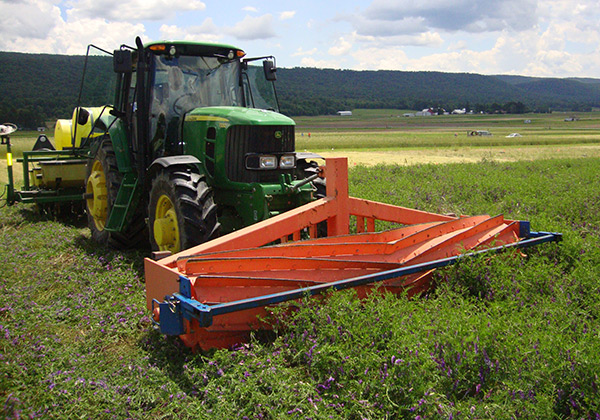To Optimize Cover Crops, Get Down in the Weeds
 |
|
In a race against time, hairy vetch is rolled and crimped to form a weed-suppressing mat into which cash crops will be planted, decreasing herbicide use. Credit: Clair Keene, Penn State. |
On the rich Pennsylvania tilth, a tractor with a bright orange roller in front flattens hairy vetch to the earth. It’s 2008 and weed scientist Bill Curran of the Pennsylvania State University aims to solve a question hounding farmers of no-till field crops: how much cover crop biomass will reduce or eliminate the need for herbicides?
In this race against time, hairy vetch and cereal rye need to be crushed at their peak in the spring, but not so late that newly planted corn and soybeans can’t grow to maturity. Curran and partners in Pennsylvania (the Rodale Institute), Virginia, and Maryland collaborated on a three-year RIPM research/extension grant: Developing a Decision Framework that Optimizes Cover Crop Integration for Weed Suppression in Northeast Cropping Systems. They wanted to find the sweet spot for minimizing weeds and maximizing field crop production.
The team looked at three aspects of cover crops: planting date (fall), termination date (forming a weed-suffocating mat into which the field crop is planted in the spring), and how thickly cereal rye is planted. They measured suppression by comparing the mass of the cover crop to the mass of the weeds, and subsequently the soybean or corn grain yield.
The results? Cover crops need to produce 6,000–8,000 pounds of dry matter per acre to suppress weeds in the mid-Atlantic region (generally, more is needed in the South than in the North). The fall planting date didn’t matter as much as the spring termination date; both vetch and cereal rye had to be rolled at just the right time or they’d spring back to life. In no-till corn, terminating the hairy vetch and planting corn in late May (in Maryland) and early- to mid-June (in Pennsylvania) increased cover crop biomass and improved weed suppression. Curran now advises farmers to minimize weed seed deposits into their “weed seed bank” (seeds waiting in the soil to sprout). He says organic growers should seed cereal rye thickly—up to 3 bushels per acre—in early fall.
Supplemental weed control (cultivation or herbicides) benefited both corn and soybeans. Post-emergent herbicides decreased weeds more effectively than cultivation in soybeans; in corn, they both generally improved yields. Says Curran, “We didn’t use atrazine and we could cut residual herbicide use in corn at least in half.” The same held true for soybeans. The cover crop mulch acts like a residual herbicide for a few weeks before either the high residue cultivator or Post herbicide controls the escapes.
From 2008–2010, Curran and his collaborators shared the results of this work with more than 1,175 farmers and educators via field days, tours, classes, and conferences. After one event, 93% of participants said they had increased their knowledge. The team’s $166,900 grant led to a $2.3 million grant from USDA’s Organic Agriculture Research and Extension Initiative (OREI) in 2011 and a second OREI grant for $2 million in 2014.
— by CARRIE KOPLINKA-LOEHR
